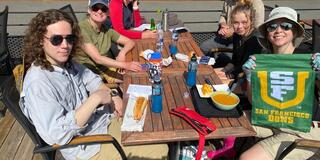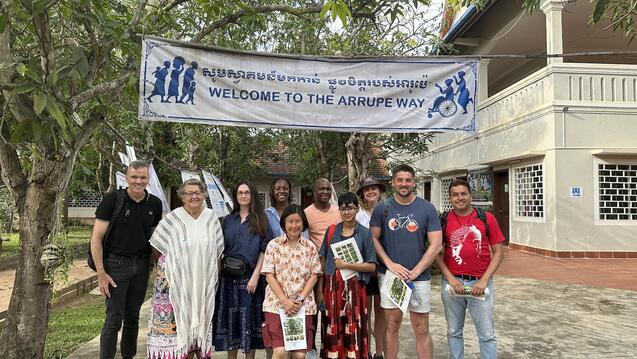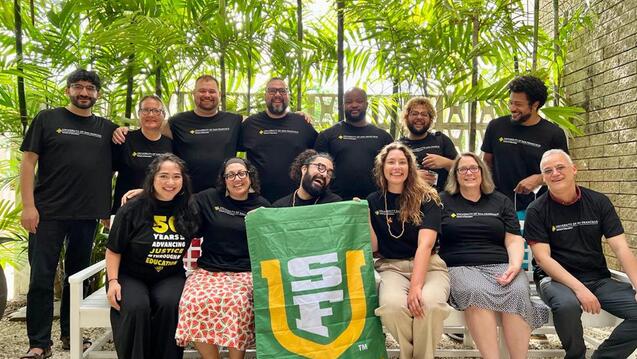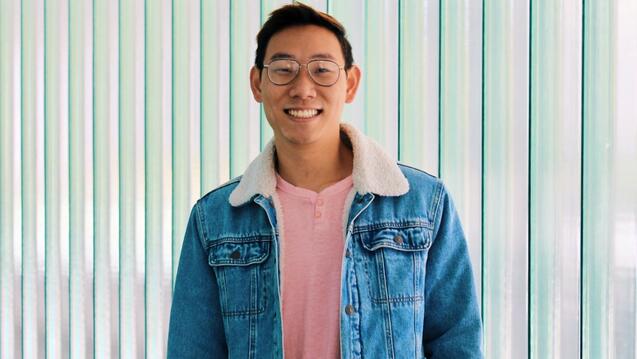USF Graduate Student Completes 600-Mile Camino de Santiago Pilgrimage

In May, my dream to walk the pilgrimage of the Camino de Santiago became reality.
For more than 1,000 years, peregrinos, or pilgrims, have walked to the Cathedral of Santiago de Compostela in western Spain to seek the relics of Saint James. My 19-year-old son and I arrived in the 12th century village of St. Jean Pied de Port, France, the start of the 500-mile Camino Frances, or French Route. We obtained the traditional “pilgrim’s passport” and the identifying symbol of Camino pilgrims, a scallop shell. Thousands of markers across Spain point the way to Saint James with a simple scallop symbol and yellow arrow. Properly equipped as peregrinos, we tried out the traditional greeting of “Buen Camino” and took our first steps toward Santiago.
Ahead, the Pyrenees loomed — the first of many challenges on a route that required walking about 17 miles per day for six weeks. The tranquil French streets soon gave way to a 4,600-foot climb. The steep mountains and layered valley views took our breath away as we climbed endlessly toward the sky. I reached the peak of Col de Leopoeder with burning lungs and shaking legs. At that point, the 485 miles between me and Santiago seemed impossible. However, as I quickly learned, “the Camino provides.”
Each exhausting climb provided a breathtaking view and a rejuvenating descent. The Camino unrolled a tapestry of landscapes and ancient architecture. While sunshine, misty rain, or fog painted the countryside, we explored historic and religious sites, regional delicacies, tiny hamlets as well as modern Spanish cities at the pace of 2–3 miles per hour. After two weeks of walking, my oldest son joined us. We were now a trio: a mother and two sons, all students, tightly bound to each other and to a bigger family of Camino pilgrims. My heart sang as the miles flowed by.
The Camino Family
I wore a green and gold USF flag attached to my backpack, and it sparked conversations everywhere. Pilgrims asked about USF and about my graduate program in public leadership.
At the conclusion of my pilgrimage, I gave the USF flag to the San Francisco/San Ignatius residence hall at the University of Santiago de Compostela.
Fellow travelers proved to be the most rewarding part of the pilgrimage. We encountered peregrinos of all ages from Slovenia, Italy, Ireland, Germany, New Zealand, Brazil, Canada, Sweden, Australia, Mexico, South Korea, Puerto Rico, Spain, and the U.S. We heard “Buen Camino” in dozens of accents. Our walk became an exercise in international relations. Our shared adversity and achievement forged genuine friendships. One-time strangers shared food, first aid supplies, and encouragement as needed. Our international melting pot became a nomadic Camino family. The world is a small place on the Way of Saint James.
A Pilgrim is Grateful
Along the route, we chose the traditional peregrino experience — traveling on foot, carrying our belongings, and eating simple meals at local cafes. We sheltered in hostels called albergues, often in converted monasteries, distilleries, or guest houses. With bunk beds, up to 40 people shared a room. Each afternoon, we hand-washed our clothes, cared for our feet, and took a much-needed siesta.
Each pilgrim makes the Camino their own. We modified our itinerary, diverting to the Camino Ingles (there are dozens of routes). This 75-mile route down the Galician coast allowed my sons to receive their compostelas, signifying completion of a Camino route, during their limited time. After celebrating their accomplishment, my heart went from soaring to breaking as my sons returned to the U.S. As a solo peregrina, I resumed the French Route. Within a day, I ran into members of my Camino Frances family. I was not alone after all.
I sought this journey to gain self-confidence and a deeper self-understanding, and the Camino provided. I expected challenges like fatigue, solitude, and physical discomfort (blisters!). The Camino also provided these, but in small doses. The presence of both my true family and my Camino family boosted my spirits, inspired my curiosity, and restored my energy.
I walked about 600 miles over 47 glorious days. Much remains to be explored, and I am already planning my next Camino. This pilgrimage bolstered my faith — in myself, in my spirituality, and certainly in humanity. Buen Camino!


